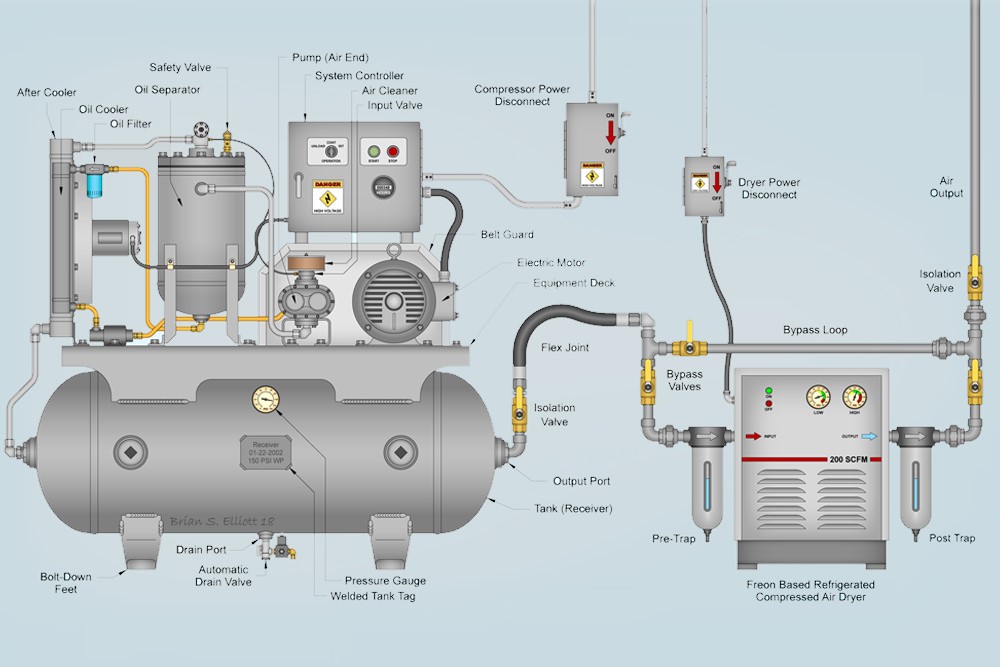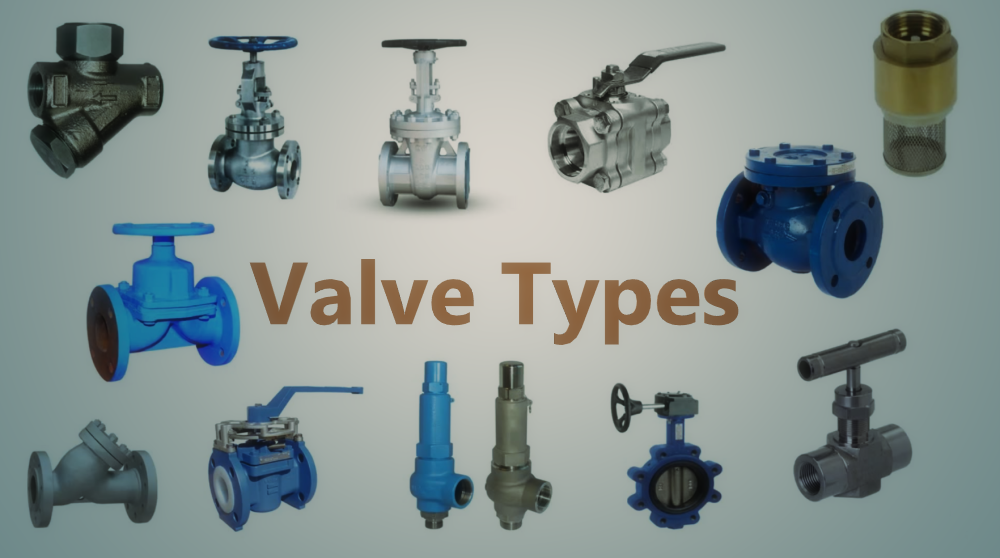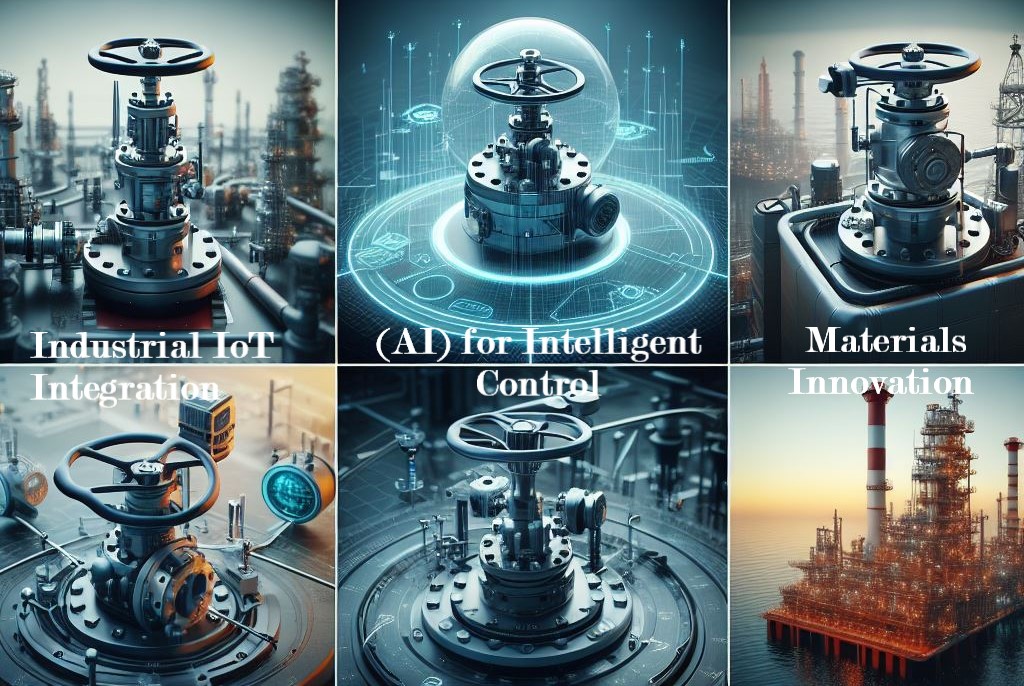Elevating Industrial Performance: The Significance of Compressed Air Control Valves
08.03.2024
In the field of industrial equipment, where precision is of the utmost importance, the unsung hero of smooth operation is the compressed air control valve. This article is a comprehensive resource for those seeking to improve their understanding of industrial equipment, from building a foundational knowledge to navigating the cutting edge of technological advances that are shaping the future.
Understanding Compressed Air Control Valves
Compressed air control valves are essential parts of compressed air system management and regulation, and they are widely used in industrial processes. These valves ensure optimal performance and efficiency in a variety of industrial applications by controlling the compressed air flow, pressure, and direction within a network.
Importance of proper control in industrial processes
Precise management of compressed air is essential in the field of industrial operations to attain maximum efficiency and performance. Pneumatic tools, machinery, and equipment in the manufacturing, automation, and other industries are powered by compressed air systems. The exact control of air pressure, volume, and direction is critical to the proper operation of these systems, and compressed air control valves provide this duty with ease.
One of the key advantages of using these control valves lies in their ability to enhance system stability. By carefully adjusting air flow and pressure levels, operators can prevent issues such as overpressurization or underpressurization, mitigating the risk of equipment damage and ensuring a consistent output. This precision control not only extends the lifespan of pneumatic components but also contributes to the overall reliability of the industrial processes.
Another important factor that is impacted by the appropriate management of compressed air systems is energy efficiency. Overpressurization can result in needless energy use, raising operating expenses and having an adverse effect on the environment. With the use of compressed air control valves, operators can adjust system settings to maximize energy efficiency and minimize waste. This increased productivity not only supports environmental objectives but also improves the profitability of industrial processes.
Furthermore, the importance of precise control becomes evident in applications that demand varying levels of air pressure or flow at different stages of the production process. Compressed air control valves allow for dynamic adjustments, catering to the specific requirements of each operational phase. This flexibility ensures that industrial processes can adapt to changing demands, ultimately leading to increased productivity and operational versatility.
The proper control of compressed air systems through well-designed and strategically placed control valves is indispensable in industrial settings. From ensuring equipment longevity and stability to promoting energy efficiency and adaptability, these valves serve as the linchpin for optimizing the performance of compressed air systems, contributing significantly to the overall success of industrial processes.
Explanation of compressed air systems
In the realm of industrial endeavors, compressed air systems stand out as essential powerhouses, fueling an array of tools and processes spanning diverse sectors. These systems boast a complex synergy of components, where the compressed air control valve assumes a pivotal role as the conductor, deftly choreographing the fluidity of the entire operation. To grasp the paramount importance of this valve, let's delve into a comprehensive exploration of compressed air systems.
Components of a Compressed Air System
A compressed air system is made up of several interconnected parts, each of which has a distinct function in the production, processing, and distribution of compressed air. Usually, these elements consist of:
1. Air Compressor
The air compressor, which is the first component of any compressed air system, is in charge of taking in ambient air and compressing it to the appropriate pressure. Different types of compressors, including centrifugal, rotary screw, and reciprocating models, are available to meet different industrial requirements.
2. Air Treatment Components
Compressed air is subjected to necessary treatment prior to entering the distribution network in order to guarantee its quality and avert possible problems. This treatment includes processes like:
- Filtration: eliminating impurities and particulates from compressed air.
- Drying: removing moisture to stop corrosion and increase system performance.
- Air Regulation: removing moisture to stop corrosion and increase system performance.
3. Compressed Air Storage
To accommodate fluctuating demand, compressed air systems often incorporate storage tanks. These tanks act as buffers, ensuring a stable and continuous supply of compressed air during peak usage periods.

4. Distribution Network
Compressed air is transported from the source to numerous applications across the facility via a system of pipes and hoses. The compressed air control valve plays a crucial function in precisely managing the airflow at various places within this network.
- The Role of Compressed Air Control Valve in the System
In this orchestra of parts, the compressed air control valve plays the role of the conductor. This valve, which is positioned strategically inside the distribution network, controls compressed air flow and directs it to particular tools or processes as needed. Because of its capacity to vary pressure and volume, every application will receive the exact quantity of compressed air needed to function at its best.
- Efficiency and Precision in Operation
As the control valve opens and closes, it modulates the airflow, allowing for efficient energy use and preventing wastage. This level of precision is crucial in industries where different tools and processes have varying compressed air requirements.
- System Optimization and Energy Efficiency
By strategically placing control valves at key points in the distribution network, operators can optimize the system for energy efficiency. The ability to control airflow prevents overpressurization, reducing energy consumption and operational costs.
- Adapting to Dynamic Industrial Environments
Compressed air systems are inherently versatile, catering to the dynamic demands of industrial environments. The control valve, acting as the gatekeeper, enables the system to adapt to changing requirements, ensuring a responsive and reliable supply of compressed air.
Overview of different valve types
A wide range of valve types are carefully created in the challenging field of compressed air control valves to satisfy specific industrial needs and operational complications. Gaining a comprehensive understanding of these many types of valves is necessary in order to choose the best solution tailored to the unique requirements of a particular application.

1. Globe Valves
The spherical body of a globe valve and its moveable disk, or plug, which is positioned perpendicular to the compressed air flow, are its distinguishing features. Because of this design, airflow may be precisely controlled by varying the plug's position inside the valve.
Applications:
Globe valves work well in situations where precise and meticulous management of compressed air flow is crucial. Because of their design, they are perfect for processes that need to be precisely regulated in terms of both pressure and volume.
2. Ball Valves
Ball valves feature a spherical closure element, the ball, with a hole through its center. The ball is positioned within the valve body and can be rotated to control the flow of compressed air. When the hole aligns with the pipe, the valve is open, and when rotated perpendicular, it is closed.
Applications:
Known for their simplicity and quick on/off operation, ball valves are suitable for applications where full or no airflow is required. They find utility in systems where rapid response and shutoff are critical, such as emergency shutdown scenarios or in pneumatic tools.
3. Butterfly Valves
The disc's form, which resembles butterfly wings, gives butterfly valves its name. By lining up with or aligning perpendicular to the pipe, this rotating disc inside the valve body regulates the flow. Butterfly valves have a small, lightweight construction.
Applications:
Butterfly valves are used in large-diameter pipelines because they are easy to use and reasonably priced. They are a common option in HVAC systems and some industrial processes because they are appropriate for situations where a prompt response to variations in airflow is required.
Factors to Consider When Choosing Control Valves
The effectiveness and dependability of an industrial system are directly impacted by the choice of compressed air control valve, which is a crucial choice. In order to make an informed decision, a number of criteria need to be carefully taken into account to make sure the control valve perfectly fits the unique needs of the compressed air system. Let's examine the crucial elements that require consideration throughout the choosing procedure.
1. Pressure Requirements
Different compressed air pressure levels are required for different industrial processes and applications. It is crucial to evaluate the system's pressure needs and select a control valve whose pressure rating complies with these requirements. Choosing a valve that is capable of withstanding the necessary pressure guarantees life and optimal performance.
2. Temperature Considerations
The performance of the materials inside a control valve is greatly impacted by the operating temperature of an industrial setting. Severe heat can cause material deterioration and reduce the valve's overall efficiency. It is crucial to choose a control valve made of materials that can survive the high and low temperatures encountered in the specified application.
3. Material Compatibility
Industrial environments frequently face the problem of corrosion, and selecting the right materials for the control valve is essential to reducing this risk. It is crucial to make sure that the materials used to manufacture the valve are compatible with the compressed air and any possible impurities present in the system. This improves the longevity of the valve and reduces the possibility of faults.
4. Flow Characteristics
Different control valves exhibit distinct flow characteristics, influencing how they modulate the airflow within the system. It's essential to choose a valve with flow characteristics that align with the specific requirements of the application. Whether linear, equal percentage, or quick opening, selecting the right flow characteristic enhances the precision and effectiveness of the control valve.
5. Size and Port Configurations
The compressed air system's flow capacity must be taken into account while sizing the control valve. Inefficiencies, higher energy usage, and even system breakdowns might result from choosing a valve that is too small. In order to guarantee compatibility with the overall system design, it is also essential to take into account port configurations, such as single-port or multi-port.
6. Actuation Methods
There are several ways to operate control valves: hydraulic, electric, pneumatic, and manual. The level of automation required, the desired response time, and the complexity of the control system are some of the criteria that influence the choice of actuation mechanism. By weighing these variables, one may be sure that the actuation technique chosen will meet the compressed air system's operational requirements.
7. Maintenance Requirements
Reducing downtime and guaranteeing constant performance need an understanding of a control valve's long-term maintenance requirements. Choosing a valve with easily accessible parts, unambiguous maintenance instructions, and a solid reputation for dependability facilitates a more efficient and economical functioning.
8. Compliance with Industry Standards
The safety and effectiveness of industrial operations depend critically on adherence to industry standards and regulations. Selecting a control valve that conforms to applicable standards guarantees that the apparatus fulfills the necessary safety and performance requirements.
Installation and Maintenance Tips
The installation and maintenance of compressed air control valves are pivotal steps in ensuring their longevity, optimal performance, and the overall efficiency of an industrial system.
Installation Tips
1. Precise Positioning: Ensuring the proper placement of the control valve within the compressed air system is fundamental. Position it in a location that allows for easy access, optimal visibility, and efficient operation. Consider factors such as proximity to other components, accessibility for maintenance, and adherence to system design specifications.
2. Correct Orientation: Pay careful attention to the correct orientation of the control valve during installation. Incorrect positioning can lead to operational inefficiencies, increased wear and tear, and potential safety hazards. Follow the manufacturer's guidelines regarding the valve's preferred orientation for optimal performance.
3. Sealing and Leak Prevention: Achieving an airtight seal is critical to prevent leaks in the compressed air system. During installation, use high-quality gaskets and seals, and ensure that all connections are tight and secure. Conduct thorough leak tests post-installation to identify and address any potential issues promptly.
4. Proper Piping Support: Provide adequate support for the piping connected to the control valve. Proper support minimizes stress on the valve and prevents misalignment, which can compromise its functionality. Use appropriate clamps, brackets, or hangers to secure the piping and maintain stability.
5. Compliance with Regulations: Adhere to industry standards and regulations during the installation process. Compliance ensures the safety, efficiency, and regulatory approval of the compressed air system. Familiarize yourself with relevant codes and guidelines to guarantee a seamless and compliant installation.
Maintenance Tips
1. Regular Inspection: Establish a regular program for inspecting the control valve and its related parts. Frequent visual examinations assist in spotting early indications of deterioration, corrosion, or wear. Prompt problem solving can save expensive repairs and increase the valve's lifespan.
2. Lubrication: For the control valve to operate smoothly, proper lubrication is essential. Regarding the kind and quantity of lubricant, heed the manufacturer's recommendations. Proper lubrication lowers friction, lessens wear on moving components, and improves the valve's overall performance.
3. Cleaning and Debris Removal: To avoid dust, debris, or pollutants building up around the control valve, keep the area tidy. Keep the valve and its surroundings clean on a regular basis to guarantee smooth operation. Clear away any debris that could cause the valve to malfunction.
4. Calibration Checks: Periodically calibrate the control valve to verify its accuracy and precision. Calibration ensures that the valve continues to perform within specified parameters, preventing inaccuracies in pressure regulation and airflow control. Follow the manufacturer's guidelines for calibration procedures.
5. Training and Documentation: Provide comprehensive training to maintenance personnel responsible for the control valve. Ensure they are familiar with proper maintenance procedures, troubleshooting techniques, and safety protocols. Maintain detailed documentation of installation dates, maintenance activities, and any repairs undertaken, facilitating a systematic and well-documented maintenance history.
Emerging technologies in the field
In the ever-evolving landscape of industrial equipment, compressed air control valves are not immune to the influence of cutting-edge technologies.
1. Digitalization and Smart Control Valves:
The way compressed air systems are managed is being revolutionized by the incorporation of digital technologies and smart control valves. Digital control valves improve accuracy and responsiveness by utilizing sensors, connection, and data analytics. Real-time data communication between these valves allows for predictive maintenance, optimal energy use, and increased system efficiency.
Potential Impact:
Digital control valve usage is expected to boost automation, decrease downtime, and improve energy efficiency. Remotely monitoring and adjusting valve performance enables more proactive, data-driven decision-making that revolutionizes the control and optimization of industrial systems.
Predictions for the Future of Control Valves
As we peer into the future of control valves in compressed air systems, several key trends and advancements are anticipated to shape the industry.
1. Enhanced Connectivity and Industrial IoT Integration:
Future Prospects: It is anticipated that control valves will play a crucial role in the development of interconnected industrial ecosystems. Improved interoperability and incorporation with the Industrial Internet of Things (IoT) will facilitate smooth communication among sensors, control systems, and valves. Real-time monitoring, data analysis, and the application of sophisticated control systems will all be made easier by this link.
Anticipated Effect: More advanced and adaptable control systems will result from the greater connectivity of control valves. Predictive maintenance, remote diagnostics, and compressed air process optimization will be made possible by the integration of the Industrial Internet of Things. This progression will lead to increased system performance overall, decreased operating costs, and increased reliability.

2. Artificial Intelligence (AI) for Intelligent Control:
Promising Development: The integration of artificial intelligence with control valves is anticipated to be a game-changing development. Large volumes of data can be analyzed by AI systems to dynamically optimize control valve settings. This intelligent control anticipates system requirements, adjusts to changing circumstances, and constantly optimizes operational parameters for optimal effectiveness.
Anticipated Effect: Artificial Intelligence in control valves is expected to herald in a new era of self-adjusting and adapting systems. With this level of precision, efficiency, and reactivity, intelligent valves can adapt on their own to changes in demand, the environment, and system dynamics.
3. Materials Innovation for Performance Enhancement:
Anticipated Development: New materials with improved durability, resistance to corrosion, and operational longevity will be created as a result of materials science advancements. Extremely tough materials will be developed in order to guarantee long-term valve performance in a variety of industrial settings.
Anticipated Outcome: Utilizing cutting-edge materials will help to boost dependability and lower maintenance needs. Control valves made of these materials will last longer and require fewer replacements because of their increased resistance to deterioration, wear, and corrosion.
Conclusion
The careful selection of control valves is the first step in the pursuit of an optimum compressed air system. Every form of valve plays a distinct role in the wide range of valve types, which include butterfly, ball, and globe valves. It becomes crucial to match the decision with certain industrial requirements.
Industrial landscapes are changing as a result of the digitalization and integration of smart control valves in this age of technological ascendancy. Equipped with sensors and connection, smart valves surpass conventional limitations by offering instantaneous data insights. The implementation of these advances creates opportunities for energy efficiency, predictive maintenance, and an all-around more efficient system. Using these technical advancements when choosing a valve becomes a calculated move to ensure that industrial processes are future-proof.